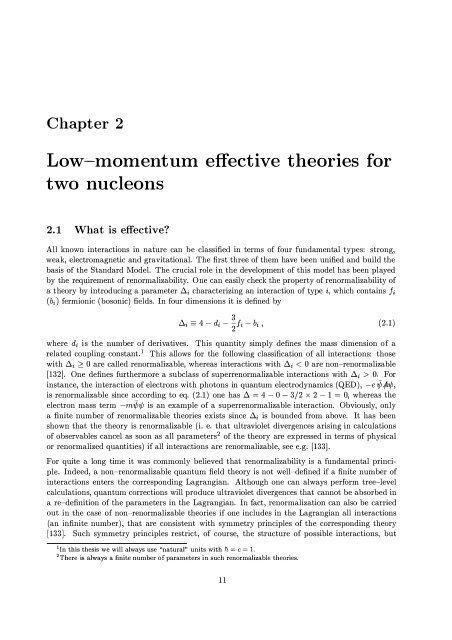The Nucleon-Nucleon Interaction in a Chiral Effective Field Theory
The Nucleon-Nucleon Interaction in a Chiral Effective Field Theory
The Nucleon-Nucleon Interaction in a Chiral Effective Field Theory
Create successful ePaper yourself
Turn your PDF publications into a flip-book with our unique Google optimized e-Paper software.
Chapter 2<br />
Low-momentum effective theories for<br />
two nucleons<br />
2.1 What is effective?<br />
All known <strong>in</strong>teractions <strong>in</strong> nature can be classified <strong>in</strong> terms of four fundamental types: strong,<br />
weak, electromagnetic and gravitational. <strong>The</strong> first three of them have been unified and build the<br />
basis of the Standard Model. <strong>The</strong> crucial role <strong>in</strong> the development of this model has been played<br />
by the requirement of renormalizability. One can easily check the property of renormalizability of<br />
a theory by <strong>in</strong>troduc<strong>in</strong>g a parameter ßi characteriz<strong>in</strong>g an <strong>in</strong>teraction of type i, which conta<strong>in</strong>s fi<br />
(bi) fermionic (bosonic) fields. In four dimensions it is def<strong>in</strong>ed by<br />
ß· = 4-d·--f· -b·<br />
2 - 2<br />
3<br />
2 2 2 , (2.1)<br />
where di is the number of derivatives. This quantity simply def<strong>in</strong>es the mass dimension of a<br />
related coupl<strong>in</strong>g constant.1 This allows for the follow<strong>in</strong>g classification of all <strong>in</strong>teractions: those<br />
with ßi 2: 0 are called renormalizable, whereas <strong>in</strong>teractions with ßi < 0 are non-renormalizable<br />
[132]. One def<strong>in</strong>es furthermore a subclass of superrenormalizable <strong>in</strong>teractions with ßi > O. For<br />
<strong>in</strong>stance, the <strong>in</strong>teraction of electrons with photons <strong>in</strong> quantum electrodynamics (QED), -e1{;j'ljJ,<br />
is renormalizable s<strong>in</strong>ce accord<strong>in</strong>g to eq. (2.1) one has ß = 4 - 0 - 3/2 x 2 - 1 = 0, whereas the<br />
electron mass term -m1j;'ljJ is an example of a superrenormalizable <strong>in</strong>teraction. Obviously, only<br />
a f<strong>in</strong>ite number of renormalizable theories exists s<strong>in</strong>ce ßi is bounded from above. It has been<br />
shown that the theory is renormalizable (i. e. that ultraviolet divergences aris<strong>in</strong>g <strong>in</strong> calculations<br />
of observables cancel as so on as all parameters2 of the theory are expressed <strong>in</strong> terms of physical<br />
or renormalized quantities) if all <strong>in</strong>teractions are renormalizable, see e.g. [133].<br />
For quite a long time it was commonly believed that renormalizability is a fundamental pr<strong>in</strong>cipIe.<br />
Indeed, a non-renormalizable quantum field theory is not well-def<strong>in</strong>ed if a f<strong>in</strong>ite number of<br />
<strong>in</strong>teractions enters the correspond<strong>in</strong>g Lagrangian. Although one can always perform tree-Ievel<br />
calculations, quantum corrections will produce ultraviolet divergences that cannot be absorbed <strong>in</strong><br />
are-def<strong>in</strong>ition of the parameters <strong>in</strong> the Lagrangian. In fact, renormalization can also be carried<br />
out <strong>in</strong> the case of non-renormalizable theories if one <strong>in</strong>cludes <strong>in</strong> the Lagrangian all <strong>in</strong>teractions<br />
(an <strong>in</strong>f<strong>in</strong>ite number), that are consistent with symmetry pr<strong>in</strong>ciples of the correspond<strong>in</strong>g theory<br />
[133]. Such symmetry pr<strong>in</strong>ciples restrict, of course, the structure of possible <strong>in</strong>teractions, but<br />
1 In this thesis we will always use "natural" units with 1i = c = l.<br />
2<strong>The</strong>re is always a f<strong>in</strong>ite number of parameters <strong>in</strong> such renormalizable theories.<br />
11












